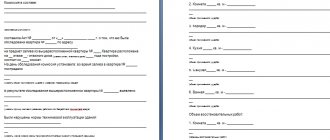Who draws up an apartment flood report?
When flooding occurs, it is necessary to inform the emergency service about this in order to eliminate the cause, if it is not an open tap at the neighbors - then you need to inform them, if possible, that they caused this situation. Then, as soon as possible, you need to draw up an act in accordance with the accepted rules. It is of great importance here who draws up the act of flooding the apartment. In order for it to be recognized by all authorities, it must be completed and signed by a commission, which, according to the rules, must include:
- At least one representative of the management company.
- The culprits.
- Victims.
Who can draw up a deed?
The responsibility for drawing up the report falls on the engineer of the management company. However, if the house does not use the services of a management company, then it is permissible to call an HOA engineer.
If the house does not belong to the HOA, then to draw up the act it is necessary to involve the person in charge of the house. It is necessary to call 2 neighbors as witnesses. They must be Russian-speaking and of legal age.
When drawing up a report, it is advisable to invite the person responsible for the accident. He must participate in the inspection process. The compilation process can be filmed. If the culprit does not agree with the contents of the act, then he can record his refusal to sign the document.
Note! If the act is drawn up by the victim independently, without the participation of witnesses, the building manager, HOA or management company engineers, then the document may not be accepted by the court for damages.
How to draw up a claim for compensation for damage from flooding of an apartment? Step by step order
What to do and how to recover damages if the neighbors above flooded? Step-by-step instruction
Report on apartment flooding, deadlines for drawing up
The basic rules according to which utilities provide services to apartment owners are regulated by government decree No. 354 dated May 6, 2011. It, among other things, discusses how to correctly draw up an act of flooding an apartment, the timing of drawing up the document, and who draws it up.
According to the resolution, a report on the consequences must be drawn up no later than 12 hours from the moment the victim contacts the emergency service with a report of the flood.
It is strongly recommended to comply with this period provided for by the rules, so if there is a possibility that the management company or the HOA will delay the departure of a specialist, you should come and write a statement about the flood in the apartment and call an employee.
If, even after writing the statement, the company remains silent or refuses to send an employee to draw up the paper, violating all established rules (which in itself is suspicious and suggests that the flood could have occurred through its fault), then the victim, as the person to whom this document is needed, it will be possible to appeal to the court and the prosecutor's office with a complaint about the actions, or more precisely, the inaction of the management company in terms of assessing the consequences of the bay. To do this, you must provide a second copy of the application to the HOA or management company with a mark of acceptance.
Attention! Need flood protection? in the form, go to the lawyer consultation , go, free !
Official website of the Supreme Court of the Russian Federation
The Supreme Court (SC) of the Russian Federation made important clarifications for the apartments affected by the flood: the lack of documents confirming the nature and extent of the damage caused, and the cost of the repair work carried out are not grounds for refusing to collect compensation. Also, the plaintiffs may make a mistake with the defendants in the flood case; the court cannot refuse their claims because of this mistake, but must itself remove all obstacles to restore justice, the highest authority emphasizes.
The Case of the Flood
A resident of the Stavropol Territory filed a claim against her neighbors and the management company for compensation for damage caused by the flooding of her apartment.
The plaintiff asked the court to jointly and severally recover the cost of restoration repairs, legal costs for assessing damage and conducting a forensic examination, as well as the cost of state fees. The total amount of the claim was more than 370 thousand rubles.
According to the case file, the cause of the incident was a broken pipe in the hot water supply in the apartment above. As a result, the ceiling tiles in the living room, kitchen and hallway, the floor in the hallway and almost the entire bathroom were damaged. The next day the management company drew up a report about this.
The defendants did not deny or refute the damage caused and the document drawn up, but they asked to refuse the claims.
Nevertheless, the Oktyabrsky Court of Stavropol satisfied the claim and even recovered in favor of the victim additional costs for conducting a judicial construction and technical examination - a little more than 21.5 thousand rubles.
However, the Stavropol Regional Court completely overturned this decision and issued a ruling dismissing the claim in full. Moreover, the appeal recovered the costs of the examination from the plaintiff.
The victim of the apartment flood did not agree with this decision and filed a complaint with the Supreme Court.
Who is to blame for the bay?
The district court, satisfying the plaintiff’s demands, proceeded from the fact that material damage to the tenant was caused by both the neighbors and the management company, since they made a mutual decision to make changes to the hot water supply system.
“There are a set of conditions for compensation for damage caused as a result of flooding of the premises, the fault of the apartment owners, who should not have unauthorizedly made a connection into the common house hot water supply pipe, the fault of the defendant Housing Management Company No. 4 LLC, whose employee uncontrollably carried out the specified work, did not having agreed with the owners of the premises of the apartment building and the management company, as well as the management company’s failure to fulfill the obligation to check the temperature and humidity conditions of the basements, monitor the condition of technical communications, and timely eliminate identified violations,” the first instance indicated.
The appellate court considered that joint and several liability cannot arise, since the section of the hot water supply engineering system, the cut into which led to the flood, belongs to the common property of the house.
Consequently, the regional court decided, the management company is responsible for such a breakthrough, since it poorly performed its duty to ensure the technically sound condition of the common property.
The court did not receive evidence that the residents of the apartment above were also responsible for the flood, the appeal indicated.
She also noted that the plaintiff did not provide evidence to the trial confirming the types and costs of repair work, the costs of materials and equipment necessary to eliminate defects that arose solely as a result of flooding. That is, the plaintiff has not proven the amount of material damage caused as a result of the flood, the regional court believes.
The Judicial Collegium for Civil Cases of the Supreme Court found that when considering the case, the appellate court committed a significant violation of the norms of substantive and procedural law.
Responsibility of the management company
In its decision, the Supreme Court analyzed in detail the responsibilities of the management company and the concepts of common property in the house. He cites subparagraph 3 of paragraph 1 of Article 36 of the Housing Code of the Russian Federation, according to which the owners own common property in an apartment building, including sanitary and other equipment.
In accordance with paragraph 5 of the Rules for the maintenance of common property in an apartment building, approved by Government Decree No. 491 of August 13, 2006, the common property includes in-house cold and hot water supply engineering systems, consisting of risers, branches from the risers to the first disconnecting device located on branches from the risers, the specified disconnect devices, collective (common house) cold and hot water metering devices, the first shut-off and control valves on the branches of the intra-apartment wiring from the risers, as well as mechanical, electrical, sanitary and other equipment located on these networks, reminds me of a court.
“From the above legal norms it follows that the in-house engineering systems of hot and cold water supply up to the first disconnecting device, as well as this device, are included in the common property of an apartment building,” he points out.
Clause 10 of the rules regulates that common property must be maintained in accordance with the requirements of the law (including on the sanitary and epidemiological welfare of the population, technical regulation, consumer protection) in a condition that ensures compliance with the reliability and safety characteristics of an apartment building; safety for the life and health of citizens, safety of property of individuals or legal entities, state, municipal and other property, etc.
Management organizations are responsible to the owners of premises for violation of their obligations and are responsible for the proper maintenance of common property - guaranteed by paragraph 42 of the rules.
Also, in accordance with paragraph 2.1 of Article 161 of the Housing Code, in the direct management of a house, responsibility to the owners for the safety of common property and high-quality performance of work lies with persons performing services for the maintenance and repair of common property, providing cold and hot water supply and carrying out sewerage, electricity, and gas supply ( including the supply of domestic gas in cylinders), heating (heat supply, including the supply of solid fuel in the presence of stove heating), management of municipal solid waste, the decision recalls.
“Consequently, the responsibility for maintaining and repairing the common property of an apartment building, including in-building cold water supply systems up to the first disconnection device, is assigned to the management organization,” notes the Supreme Court.
He recalls that during the trial it was established that the cause of the flooding of the plaintiff’s apartment was the failure of the first shut-off and control valve at the distribution outlet from the hot water supply riser in the apartment.
“Under such circumstances, in order to properly resolve the dispute, it was necessary to establish whether the section of the hot water supply engineering system, the break of which caused the flooding of the apartment, belongs to the common property of the apartment building and whether the management company is responsible for such a break, as well as the circumstances associated with the occurrence of the cause bay - actions (inaction) of the apartment owners from above and the management company regarding the proper maintenance and operation of the hot water supply pipe,” explains the highest authority.
The plaintiff may make a mistake with the defendant
The Supreme Court was surprised by the position of the appeal, which refused to recover damages to the apartment damaged by the flood due to the fact that the plaintiff insisted on joint liability of the neighbors and the management company.
The regional court decided that only the management company was responsible for the breakthrough, since it occurred on an area of common property. But since the applicant wanted to receive compensation from both defendants, the court decided to completely deny her demands. At the same time, the appeal referred to the possibility of the victim exercising her violated right in other ways provided by law.
Meanwhile, the appellate court did not refute the conclusion of the first instance court about the conformity of the plaintiff’s chosen method of protecting his right and did not substantiate in the determination what other method commensurate with the violated right could eliminate the violation of the plaintiff’s rights committed by the defendant, the Supreme Court points out.
It.
Amount of losses
The Supreme Court of the Russian Federation also did not agree with the conclusions that there were no grounds to recover damages from the resident due to the fact that the amount of material damage caused had not been proven. This position is not based on the law, the Supreme Court emphasizes.
He refers to paragraph 1 of Article 1064 of the Civil Code of the Russian Federation, which provides that harm caused to the person or property of a citizen, as well as harm caused to the property of a legal entity, is subject to compensation in full by the person who caused the harm.
In addition, by virtue of Part 2 of Article 56 of the Code of Civil Procedure, it is the court that determines what circumstances are important for the case, which party must prove them, and brings the circumstances up for discussion, even if the parties did not refer to any of them.
And according to paragraph 1 of Article 15 of the Civil Code of the Russian Federation, a person whose rights have been violated may demand full compensation for the losses caused to him, unless the law or contract provides for compensation for losses in a smaller amount.
The Supreme Court also provides clarifications from the plenum of June 23, 2015, in the second paragraph of paragraph 12 of which it is stated that the amount of damages subject to compensation must be established with a reasonable degree of certainty.
“In the meaning of paragraph 1 of Article 15 of the Civil Code of the Russian Federation, a claim for compensation for losses cannot be refused only on the grounds that their exact amount cannot be determined. In this case, the amount of damages to be compensated is determined by the court, taking into account all the circumstances of the case, based on the principles of fairness and proportionality of liability to the violation committed,” the highest authority emphasizes.
The Supreme Court notes that in such cases, the duty of the court is to clarify the actual circumstances of the case: establishing the fact of the flood and the culprit in the incident, the fact of damage to the plaintiff’s property and its assessment in material terms. But the appellate court did not fulfill this duty.
“At the same time, the obligation to compensate for the harm caused and cases in which exemption from such an obligation is possible are provided for by law. Failure to prove the amount of damage caused is not included in the current legislation as a basis for not imposing civil liability on the tortfeasor,” explains the Supreme Court.
He considered the violations of substantive and procedural law committed by the appellate court to be significant and insurmountable, and therefore canceled the ruling and sent the case for a new trial.
Alice Fox
Rules for drawing up an act of filling an apartment
In addition to the points described above, the rules for drawing up an act of filling an apartment regulate its design and content. The act must indicate the following information according to the rules:
- The header of the act indicates the address of the flooded apartment, the date of inspection, names, passport details and status of the commission members.
- Next comes the name: an act on the consequences of flooding a residential apartment.
- The text describes in detail what happened, for what reason and whose fault it was. If the water came from the apartment above, then according to the rules, the address of that apartment is also recorded.
- Indicate, if any, violations by neighbors or the service organization of the rules for the operation of communal property, which resulted in a flood. Also, malfunction of pipes and plumbing equipment can be a reason, which is reported in the report, along with the date of commissioning of this equipment and a description of its condition.
- The condition of the premises after the incident is described in detail: damage and defects on the ceiling, walls, floor, damage caused to objects and furnishings. According to the rules, it is necessary to clarify that all damage was a consequence of the flood.
- Form of ownership of the premises.
- Signatures of the participants.
- If the cause of the flood could not be determined, then a note indicating the convening of an expert commission is indicated.
The act must be drawn up in triplicate according to the rules: to the victim, the victim, a representative of the HOA or the management company. According to the rules, an expert assessment of damage must also be carried out in front of the commission members, who should be asked in advance for consent to carry it out and their consent must be certified with signatures.
When filling out the act of filling an apartment, the design rules should be applied standard for documents of this kind.
Lawyer's answers to private questions
I'm renting an apartment. The tenant forgot to turn off the water and left the house. The apartment on the floor below was flooded. At that moment I was on vacation and found out about the incident only after receiving a pre-trial claim. But I was not present during the inspection of the apartment. My signature is not on the document. Can I challenge the document since it was drawn up without me?
No. The law does not provide for the obligation of the victim to notify the perpetrator of the incident. The absence of a signature is also not considered a valid reason for invalidating the act.
Who calculates the amount of compensation?
Despite regulations obliging service organizations to assess the amount of compensation, they refuse to assume such responsibility and refer victims to appraisers who meet the following requirements:
- Are members of the SRO of appraisers
- Have a specialized higher education or professional retraining
- Insured for more than RUR 300,000
- Have a qualification certificate for the assessment of movable and immovable property
For an estimate, you can contact us by phone, or leave your contact information and we will call you back.
What to do if neighbors don’t let you into your apartment
You can enter someone else's apartment in two cases:
- with the consent of the residents;
- By the tribunal's decision.
When neighbors do not make contact and do not allow you into their home, there is not a single legal reason to enter your home. Remember that you do not necessarily need to inspect the condition of the apartment from above. If a plumber establishes the fact of a leak from above by inspecting your apartment, his conclusion will be sufficient for the court.
If the neighbors do not allow you into the apartment, then this must be indicated in the deed. It will be very helpful if you inspect the apartment of your neighbors who live even higher up to make sure that the flooding is not coming from above. Such inspection must also be indicated in the report.
How to protect your apartment
In order to save your apartment from all kinds of incidents, such as robbery, flooding, fire, you need to contact an insurance company for help. There are no other legally correct methods for preserving the owner’s property.
How to insure an apartment
To save your apartment from all kinds of incidents, such as robbery, flooding, fire, you need to contact an insurance company for help. There are many options for property insurance. There are no other legally correct methods for preserving the owner’s property.
How to insure an apartment against flooding
To insure an apartment against a flood, an insurance policy is issued either from a bank or an insurance company. This policy specifies the amount of compensation for damage to property and sets fixed payments as a percentage of the insurance amount.
Flooding of an apartment can occur for every apartment owner in a multi-story building. In this case, the main thing is not to panic and act according to the instructions given. To avoid an unpleasant situation with compensation for damage, it is recommended to take out insurance. This will save time and effort on resolving a conflict situation when it occurs.
Definition of the culprit
The most important thing when drawing up an act is to determine who is guilty of flooding the apartment. Without this information, the court will not have grounds for a conviction and the owner will not be compensated for damages. The determination of the guilty party occurs after calling a specialist from the housing office and recording the type of damage. In this case, photos and videos recorded on the phone will come in handy.
Neighbours
If the neighbors above are at fault, then the dispute will be settled if those responsible for the incident are adequate, or compensation may be demanded through the court.
To do this, you need to call a dispatcher from the emergency service of the management company or other representatives of the housing office and record the fact of a leak due to the fault of a third party in the report.
Housing office
If housing and communal services employees are to blame, then first of all you need to find out what category of damage is:
- broken pipe;
- battery problems;
- leaky roof.
It is important to remember your application number when contacting the Housing Office and wait for the specialists to arrive. If for some reason they refused to go to the site, you need to invite neighbors and indicate in their document the absence of specialists. The document is drawn up in 3 versions for the parties and for the employee of the management organization.
After drawing up the report, you can begin to assess the damage.
How to indicate the cause of flooding
Most often, the cause of flooding is obvious. For example, if this is a pipe break, then the commission describes it as such: “a pipe break occurred” and indicates the room in which the break occurred. If everything is not so clear, you can indicate an approximate reason.
Note. The act can subsequently be challenged in court, either in whole or in part. In particular, there may be disputes over the cause of flooding - so this must be stated carefully.







![Bank Zenit mortgage and refinancing [credit][sale]](https://bgrielt.ru/wp-content/uploads/bank-zenit-ipoteka-i-refinansirovanie-credit-sale4-330x140.jpg)

